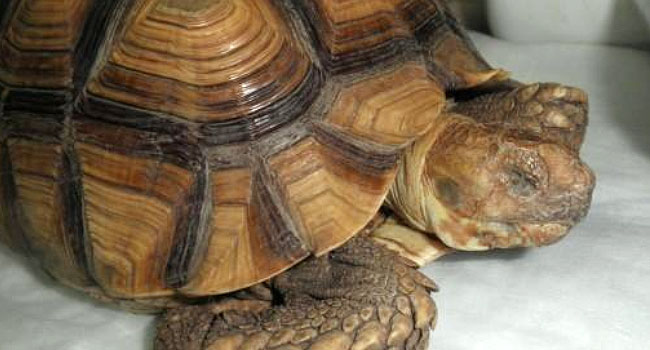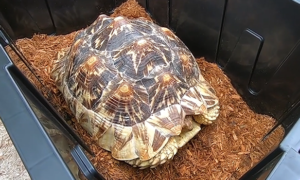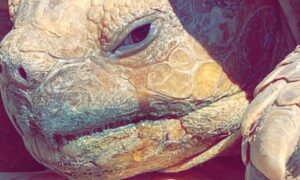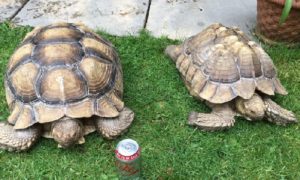Sulcata tortoises are susceptible to respiratory infection. It’s important that when raising a sulcata tortoise you look out for signs of respiratory infection in sulcata tortoises.
Respiratory infection is often minor, but it can become fatal. It is important to spot the signs early and correct the cause.
Baby tortoises are more susceptible to getting respiratory illnesses than larger tortoises. When compared to an adult tortoise, the immune system is just not as hardy in a baby tortoise. It is easier to take care of your baby sulcata and prevent illness than to have to treat an illness.
It is important to notice the signs of respiratory infection in baby sulcata early. Prolonged symptoms and an illness left untreated can become fatal for your baby sulcata tortoise.
Common Signs of Tortoise Respiratory Infection
Signs of a sick sulcata tortoise can vary. However, you’ll find that the common symptoms of upper respiratory infection in sulcata tortoises include:
- Runny nose
- Puffy or swollen eyes
- Drainage or bubbles coming from the mouth, eyes or nose
- Difficulty breathing
- Open mouth breathing
- Whistling while breathing
- Lethargic and a decrease in energy
- Excessive sneezing, coughing or gasping
- Loss of appetite
The signs of upper respiratory illness in tortoises can be slight or very obvious. You know your tortoise and what his norm is. Diagnose and treat a respiratory condition early before it manifests into something worse.
Causes of Respiratory Infection in Sulcata Tortoises
Your tortoise is unlikely to catch a respiratory illness from another tortoise unless they are housed together.
The cause of respiratory illnesses in tortoises is typically environmental. In most cases, a sulcata tortoise will get a respiratory infection because the enclosure is too cold.
Cold temperatures in the sulcata tortoise enclosure are often caused by
- A burned-out heat bulb
- A draft from a window or open door
- A fan blowing on the enclosure
- An unusually cold evening
- A drastic change in temperature
When housing a baby sulcata tortoise inside, it’s important to monitor the temperatures regularly. Check to make sure the heat bulbs are working properly. Test the temperatures with a digital temperature gun to ensure the proper heat is reaching the sulcata.

Other causes of a respiratory infection in tortoises include:
- Dirty bedding – fungal spores can grow in the bedding causing an infection.
- Mycoplasma – a microbe that is naturally kept in check by your tortoise’s immune system. If your tortoise is otherwise ill or has a vitamin deficiency, his immune system may not be able to keep the mycoplasma at bay.
- Overall habitat conditions – if the habitat (inside or outside) is too wet or too dry, your tortoise can develop a respiratory infection.
Respiratory Infection Treatment in Sulcata Tortoises
If you think your sulcata tortoise has a respiratory infection, check the enclosure temperature. Replace dead or dying heat bulbs. Sometimes all you need to do is increase the enclosure temperature, in order to treat respiratory infection in tortoises.
Increase humidity to loosen up any debris in your sulcata’s respiratory tract. Add a humidifier or reptile fogger to the enclosure. It will work much like a humidifier loosening mucus when humans have a cold.
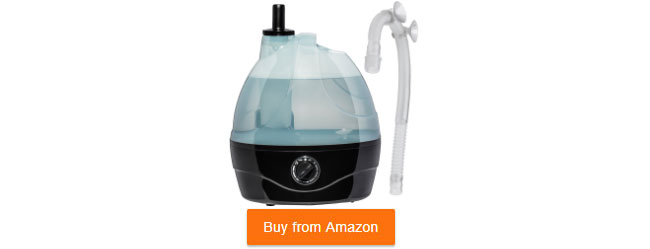
Keep the tortoise hydrated. Increase warm baths to ensure the sulcata is getting enough water.
For sulcata tortoises that are not eating, add carrot puree or carrot baby food to the warm water bath. You can also add Vita-Sol to the water, which is a highly concentrated multi-vitamin. The tortoise will absorb the nutrients through the thin skin on the throat and around the cloaca while soaking.
Reduce handling and minimize stress.
Schedule an appointment with your reptile vet. If the respiratory infection is more serious, the tortoise may need medication. Even if you do everything right at home, you may still need a reptile vet to treat the respiratory illness in your tortoise.

